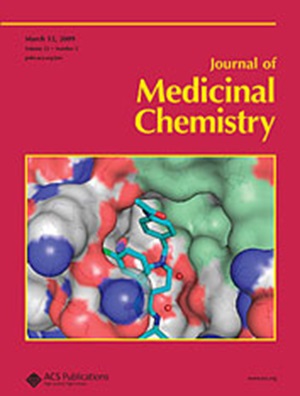A Lysosome-Targeted Iridium(III) Complex Inducing Pyroptosis for Enhanced Sonodynamic Therapy of Colorectal Cancer.
IF 6.8
1区 医学
Q1 CHEMISTRY, MEDICINAL
引用次数: 0
Abstract
Sonodynamic therapy (SDT) is a promising noninvasive cancer treatment due to its superior tissue penetration depth compared to phototherapy. Herein, we developed a lysosome-targeted cyclometalated Ir(III) complex (Lyso-Ir) as a highly efficient sonosensitizer and sonoredox catalyst for enhanced SDT against colorectal cancer. Lyso-Ir outperforms [Ru(bpy)3]Cl2 in both 1O2 generation (2.74-fold) and sonocatalytic oxidation of NADH (2.92-fold). Notably, under lysosomal pH conditions, its performance is significantly enhanced with improvements of 22.9-fold (1O2 generation) and 7.5-fold (NADH oxidation) over neutral physiological conditions, respectively. This is advantageous for tumor therapy, given the inherent weak acidity of lysosomes and the tumor microenvironment. Notably, Lyso-Ir could target the lysosome, generate 1O2 under ultrasound irradiation, induce lysosomal membrane permeabilization, activate caspase-3, trigger GSDME cleavage, and ultimately lead to pyroptosis. This is highly advantageous for overcoming apoptosis resistance and activating antitumor immune responses. This work provides a promising new strategy for the treatment of deep-seated colorectal tumors.一种溶酶体靶向铱(III)复合物诱导焦亡增强声动力治疗结直肠癌。
声动力疗法(SDT)由于其比光疗具有更强的组织穿透深度,是一种很有前途的非侵入性癌症治疗方法。在此,我们开发了一种溶酶体靶向环金属化Ir(III)配合物(Lyso-Ir),作为一种高效的声敏剂和声氧化还原催化剂,用于增强抗结直肠癌的SDT。Lyso-Ir在10o2生成(2.74倍)和NADH声催化氧化(2.92倍)方面都优于[Ru(bpy)3]Cl2。值得注意的是,在溶酶体pH条件下,其性能显著提高,比中性生理条件下分别提高22.9倍(1O2生成)和7.5倍(NADH氧化)。考虑到溶酶体固有的弱酸性和肿瘤微环境,这对肿瘤治疗是有利的。值得注意的是,Lyso-Ir可以靶向溶酶体,在超声照射下产生1O2,诱导溶酶体膜渗透,激活caspase-3,触发GSDME裂解,最终导致焦亡。这对克服细胞凋亡抵抗和激活抗肿瘤免疫反应是非常有利的。这项工作为治疗深部结直肠肿瘤提供了一种有希望的新策略。
本文章由计算机程序翻译,如有差异,请以英文原文为准。
求助全文
约1分钟内获得全文
求助全文
来源期刊

Journal of Medicinal Chemistry
医学-医药化学
CiteScore
4.00
自引率
11.00%
发文量
804
审稿时长
1.9 months
期刊介绍:
The Journal of Medicinal Chemistry is a prestigious biweekly peer-reviewed publication that focuses on the multifaceted field of medicinal chemistry. Since its inception in 1959 as the Journal of Medicinal and Pharmaceutical Chemistry, it has evolved to become a cornerstone in the dissemination of research findings related to the design, synthesis, and development of therapeutic agents.
The Journal of Medicinal Chemistry is recognized for its significant impact in the scientific community, as evidenced by its 2022 impact factor of 7.3. This metric reflects the journal's influence and the importance of its content in shaping the future of drug discovery and development. The journal serves as a vital resource for chemists, pharmacologists, and other researchers interested in the molecular mechanisms of drug action and the optimization of therapeutic compounds.
 求助内容:
求助内容: 应助结果提醒方式:
应助结果提醒方式:


